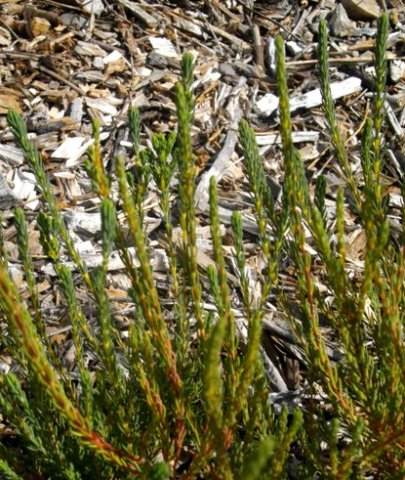Erica albens var. albens

Author: Ivan Lätti
Photographer: Thabo Maphisa
These Erica albens var. albens leaves were photographed in Kirstenbosch during March. Adhering in whorls of three to the pale or reddish stems, they are narrow, rigid and hairless.
The pedicelled flowers grow solitary but in small, dense racemes from leaf axils near stem tips, arranged around the stems like bottle brush flowers. Classified in the Platyspora Section of the Erica genus (Baker and Oliver) and according to another system as chaffy vase heaths (Manning and Helme), the flowers are small, neither hairy nor sticky. The sepals are lance-shaped and papery. The corollas are urn-shaped to shortly tubular, roundly inflated at the base and tapering to narrow throats from where they turn star-like and four-pointed by the spreading of the lobes. In spite of the plant's long blooming season, which lasts from autumn to midsummer, the white, yellowish or slightly pink flowers were not present at the time.
The species distribution is in the Western Cape, in the Swartberg Mountains, the Outeniqua Mountains, the Kammanassie Mountains and the Langeberg Mountains.
The habitat is moist higher mountain slopes. The habitat population is deemed of least concern early in the twenty first century.
There is a second recognised variety of this species, viz. E. albens var. longiflora (Manning and Helme, 2024; Vlok and Schutte-Vlok, 2015; Bond and Goldblatt, 1984; Baker and Oliver, 1967; iNaturalist; www.redlist.sanbi.org).

